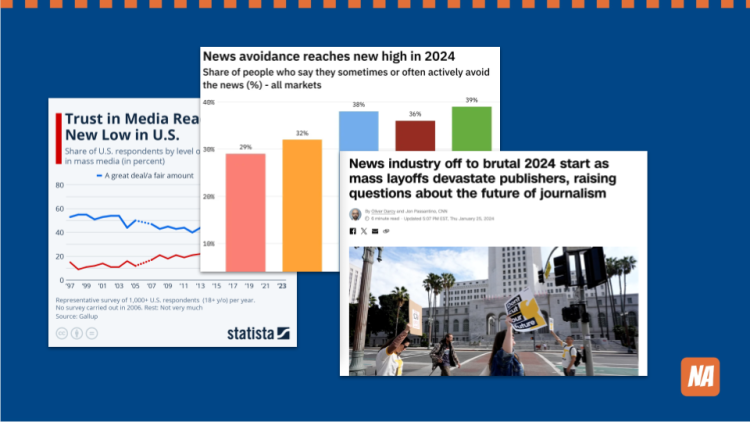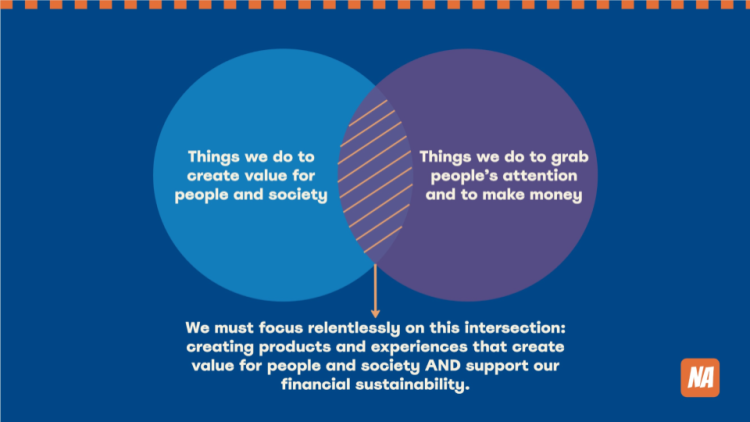Editor's note: The following is a keynote address given by ICFJ Knight Fellow Mattia Peretti at the Media Party conference in Buenos Aires in late August.
The title of this talk is “Reinventing Journalism: New Ideas for a People-Centric Sustainable Future.” There are a couple of loaded concepts in there, which we will try to unpack in the next few minutes.
First of all, a little about me: my name is Mattia and I’m here today as an ICFJ Knight Fellow, which is my “job title” this year. Until last year I was the manager of the JournalismAI initiative at the London School of Economics and Political Science, and beyond the past or present affiliations, I’m a learning experience designer, a project manager, and facilitator.
This talk is basically about a Venn diagram I’ve been obsessing about over the last few months. But before we get to the Venn diagram itself, I thought I’d start by explaining the title of the talk, and in particular from the word: “reinventing.” Because you may ask: Why does journalism need to be reinvented?
Let’s look at some headlines from the last twelve months: “Trust in media reaches new low”; “News avoidance reaches new high”; “News industry off to brutal 2024 start as mass layoffs devastate publishers.” And I’m going to stop here so we don’t all have nightmares tonight.
We agree that we have a problem, right?

The thing is that, even if we’ve allegedly been “in crisis” for the past 20 years, it seems to me that we are quite averse to consider serious systemic change, while on the other hand we’re always ready to get excited about the little cosmetic changes that make us feel like we’re doing ‘something’ even if it’s quite clear that it might grant us, at best, some marginal improvement or temporary gain.
Take AI. I’m not an AI skeptic nor someone who considers we’re wasting time with it. Just two years ago I was gracing this very stage with a talk about the “10 things everyone should know about AI in journalism.” I spent five years helping journalists understand the impact of AI on the journalism industry and especially the opportunities AI has to offer.
But earlier this year I wrote an article with the headline “It’s not about AI,” in which I argued that we are getting this AI thing all wrong. This is because I’m afraid we are tricking ourselves into thinking that we can solve our problems by just sprinkling a bit of AI on top of what we do, without considering that the problem might be that what we do is fundamentally flawed in the first place.
How we are approaching AI is just an example, but I worry that part of the reason why we face such deep issues is that we have lost touch with our mission – or at least we seem to be quite confused about it. We need to take some time to reflect on why we think journalism is so important and what role we believe it should play in societies.
Traditionally, we tend to think about the mission of journalism as informing the public about what is going on in their community, in their country, and across the world; to supply them with the information they need to make informed choices, for example about how they are going to vote in an election. But I say that’s not enough anymore. I believe we need to acknowledge that information only has value if it helps people take action and inspire positive change. Because the risk with believing that all journalism should aim to do is provide information to the public is to confuse the production of content and information with mission accomplished.
But journalism does not equal content.
The act of doing journalism most often manifests itself with the production of content – writing an article, recording a podcast, etc. But our mission is not to produce content. This might seem like a subtle difference but to me it makes all the difference in the world. Instead, we should think of journalism as a service to people and society; untangling ourselves from the journalism-equals-content equation to allow ourselves to think more creatively of how we might be of service to people and how we can create value for them.
Because I believe that journalism has the power but also the responsibility to make a positive impact on society: helping people navigate their lives, providing them with the information and the context they need to meaningfully participate in their communities, and strengthening democracy.
And I’ll tell you more: I believe that focusing relentlessly on the value our journalism creates for people and society is a necessary condition to guarantee the financial sustainability of the journalism industry.
Mind you, I say ‘necessary’ condition, not sufficient. I’m not naive to the point of not knowing we need to keep getting smarter about how we monetize our journalism. But it is necessary. Because no smart tactic or technology will make us sustainable if people don’t find any value in what we do.
And this is where the famous Venn diagram comes in handy:

In the blue bubble on the left, there are all the things we do to create value for people and society through our journalism. And we do a lot of that already. But a lot of what we do falls outside of the bubble, floating in the dark blue background, because let’s admit it: we don’t always think of the value we aim to create with our journalism.
In the purple bubble on the right, there are all the things we do to grab people’s attention and to make money. Some of them overlap with the blue bubble but a lot of them don’t: those are all the tactics and strategies we implement because we are desperate to find any little trick to get us out of the crisis we are in – but often are detrimental to our reputation and therefore to our own objectives (Taboola feeds? Misleading/clickbait-y headlines? Invasive pop-ups and auto-playing videos? Should I continue?) In that purple bubble sits lots of things we should stop doing right now.
I argue that what we must relentlessly focus on is the intersection between the two bubbles: creating products and experiences that create value for people and society and support our financial sustainability – most often precisely because of the value they create.
We must identify the things we already do that belong in that intersection and do more of them. We must find more things we can do at the intersection. We must expand the intersection until the two bubbles merge and the intersection is all that is left. Until everything we do creates value for people and society, thus supporting our financial sustainability.
I don’t know that this will be enough to get us out of the crisis. But I do know that we’re definitely not getting out of it without taking this step.
Now you’re probably about to ask me: “OK, but how do we do it?” And I’m afraid I’m going to disappoint you because I don’t really have a ready-made formula. I’d be making a lot of money if I did!
But with a group of people I know and admire, from across the industry and across the world, I’ve been laying the foundations for an initiative that I hope might help us find some answers:
News Alchemists is a movement that helps everyone in journalism put people’s needs and curiosity and the benefit of society at the center of everything they do.
I want all of us to work together to learn how we can measure the success of our organizations not just in engagement and profit but in the value our journalism creates. Because only then we might learn how to make every single editorial and business decision based on maximizing that value.
News Alchemists aims to work on this mission at three different levels:
- Advocating for the importance of embracing a people-centered approach;
- Gathering and sharing evidence of how it leads to financial sustainability and higher trust in journalism;
- Co-creating radical new solutions that create value for people and society.
You can learn more about the initiative at newsalchemists.org. Join the movement.
News Alchemists is looking for funding to continue its work beyond 2024. If you are interested in contributing to its mission or want to learn more about it, get in touch with Mattia at mperetti[at]icfj[dot]org
This article was first published on IJNet.